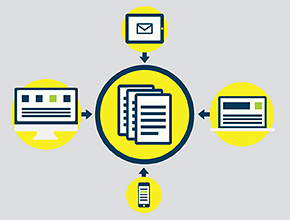As the number of channels available for marketing teams (both digital and non-digital) continues to grow, so do the number of ways businesses attempt to gain intelligence from all resulting data. Much concentration is put toward the assembly of big data, the metrics/analytics associated with it, and the insights generated from it; but what ACTION takes place as a result of big data (or any data for that matter) should be a more significant part of the discussion. Where does the resulting intelligence fit in the company’s sales and marketing mix? What change can occur as a result of its existence? And who can benefit most from intel gained from data?
First, let’s talk “aggregate” level…
Aggregate Level = Marketing
The main recipient of aggregate level multi-channel intel is Marketing. Naturally, the marketing discipline can benefit greatly from the generation of insights from data – with the primary hope being: What’s working? What isn’t? What to do more of? Or less of? Where should we most optimally allocate resources?
Business intelligence dashboards, as an example, allow stakeholders the ability to keep their fingers on the pulse of the brand and to course-correct programs where need be. Whether marketing departments actually do course-correct is a varied story. It can be difficult to eliminate a marketing program tactic mid-stream (both logistically and contractually) and actually tweaking and changing aspects of a campaign can be expensive, especially if external partners are involved.
Individual Level = Sales
Interestingly, as much as big data continues to be a hot topic, what about the “small data”, the “right” data, or the details at the individual customer or prospect level that collectively make-up what is known as “big”? How can individual-level data be leveraged? If the promise of big data is to become more effective and efficient when appealing to customers, why is it that many companies fail to leverage what they already possess (individual level intelligence)? Why is it that aggregate is often concentrated on, while individual is overlooked?
The irony is that the consolidation and analysis of all this data take place within the marketing department, and most often at the aggregate level as mentioned above. Where actual sales tend to take place in many business models (with the sales force), it would seem, the level of multi-channel intelligence available is limited if existent at all. What does aggregate analytics tell a salesperson about an individual customer? Not very much.
Aggregate level analytics are beneficial for painting a picture of a marketing campaign as a whole, but seldom will it directly assist a salesperson with an individual customer. Not surprisingly, the most useful intelligence for affecting sales is at the individual level, where the most actionable touch points exist.
Mobilizing Customer and Prospect Intel
Capturing and leveraging data at the individual level, at first blush, can seem like a huge task when in reality it’s just a question of having the right technology-enablement to do it. A new approach is in order so that brands can get closer to specific customers, not just with customized marketing content, but through an existing, always valuable resource: Salespeople.
Of course, the process of centralizing data captured within the brand’s ecosystem needs to be standardized and adopted. All identifiable data from communication channels need to be funneled to one central repository. This approach helps companies avoid the expensive consolidation process that often occurs after data has been collected without the proper approach. Also, through a centralized technological framework, data can be accessed by all departments making it easy to share the intelligence, and most notably, put it in the hands of people who can generate action from it.
If the desired result of all data intelligence, big and small, is to increase sales, then it’s imperative that companies strive to present this intel to salespeople in a way that they can actually use it. Without this approach, a tremendous opportunity to speak and interact more pointedly with prospects and customers is lost.

COMMENTS